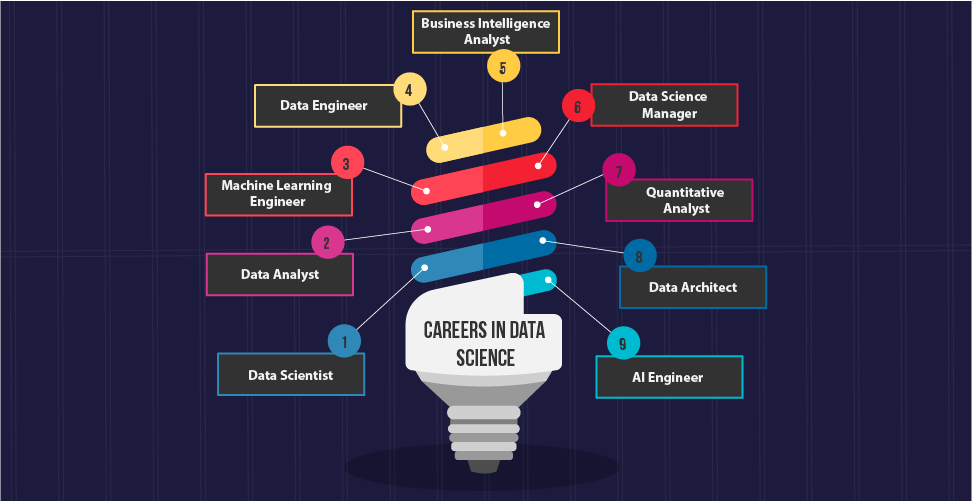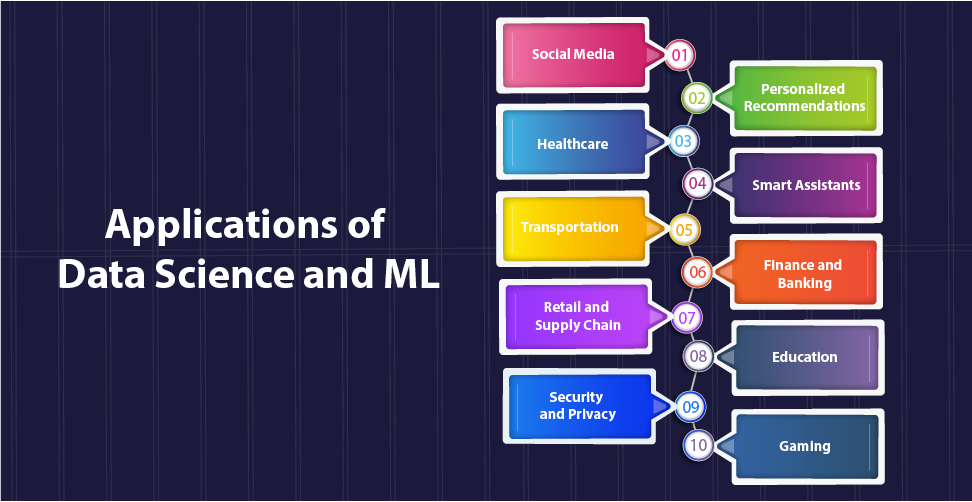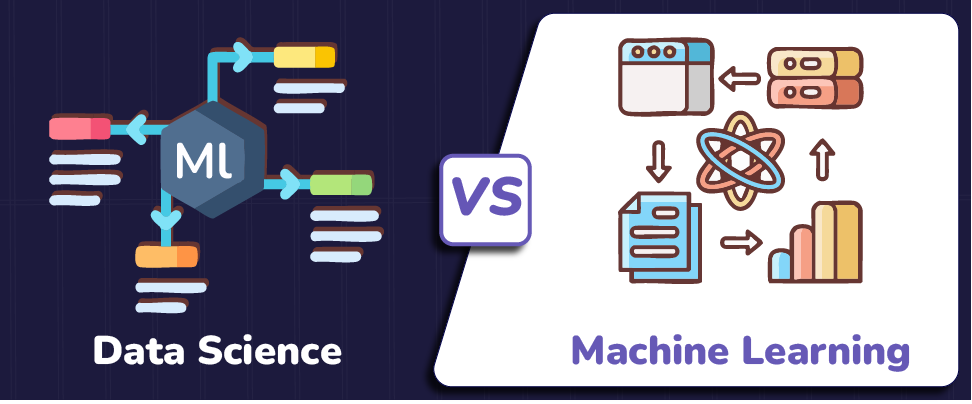Table of Contents
ToggleIntroduction

Don't miss out on your chance to work with the best
Apply for top global job opportunities today!
Data Science vs Data Analytics vs Machine Learning vs Artificial Intelligence
| Aspect | Data Science | Data Analytics | Machine Learning | Artificial Intelligence |
|---|---|---|---|---|
| Definition | A multidisciplinary field focused on extracting insights from structured and unstructured data. | The process of examining datasets to identify patterns, trends, and actionable insights. | A subset of AI where algorithms learn patterns from data to make predictions or decisions. | A broad concept of machines performing tasks requiring human-like intelligence. |
| Focus Area | Data collection, cleaning, analysis, visualization, and interpretation. | Identifying trends and providing business intelligence from historical data. | Creating models that enable systems to learn and improve from experience automatically. | Simulating human cognitive processes like reasoning, learning, and decision-making. |
| Core Techniques |
|
|
|
|
| Tools and Languages | Python, R, SQL, Hadoop, TensorFlow, Power BI, Tableau | Excel, SQL, Power BI, Tableau | Python (with libraries like Scikit-learn, TensorFlow, Keras), R | AI frameworks: TensorFlow, PyTorch Languages: Python, Java |
| Applications | Fraud detection, customer segmentation, predictive modeling, sentiment analysis | Market trend analysis, operational optimization, KPI tracking | Recommendation systems, predictive analytics, speech recognition | Self-driving cars, chatbots, virtual assistants, smart home systems |
| Outcome | Creates models and strategies for predictive and prescriptive analytics. | Provides insights and data-driven decision-making for businesses. | Automates learning and predictive decision-making from data. | Develops systems capable of reasoning, problem-solving, and adaptive behavior. |
| Future Scope | Integral to big data, personalized healthcare, and automation. | Expanding into real-time analytics, predictive forecasting, and prescriptive analytics. | Core to emerging technologies like robotics, autonomous systems, and advanced automation. | Driving innovation in robotics, healthcare, and other advanced cognitive applications. |
What is Data Science?
Data Science is a multi-disciplinary field where data scientists work on extracting insights from structured and unstructured (large) data sets. Data science experts use computer science, statistics, machine learning, and predictive analysis to find innovative solutions to complex problems. The magic of data science lies in asking the right questions. Experts study trends, explore disconnected sources of data, and find ways to analyze information much more efficiently by using data science. Data science involves discovering new patterns and insights, collecting data from various sources, organizing the information, and extracting results.
Read More: Is Data Science an Overhyped Trend?
Skills Needed to Become a Data Scientist
- Programming Skills
Expertise in languages such as Python and R helps with data manipulation, statistical analysis, and machine learning. Additionally, SQL knowledge allows you to extract and query data from databases.
- Statistical and Mathematical Expertise
A strong grasp of concepts like probability, hypothesis testing, linear algebra, and calculus is essential to model development and data analysis.
- Data Manipulation and Visualization
It is crucial to be skillful in using tools like Pandas and NumPy for data cleaning and transformation. In addition, visualization tools like Power BI and Matplotlib help communicate data insights effectively.
- Machine Learning and AI
A good data scientist is proficient in using frameworks like TensorFlow, PyTorch, and Scikit-learn on algorithms like regression, classification, clustering, and neural networks.
- Big Data Technologies
A good data scientist can skillfully manage large datasets using tools like Hadoop, Spark, and MongoDB.
- Domain Knowledge
Data science is used across various domains, which makes it crucial for data scientists to acquire a specialized understanding of domains like healthcare, finance, education, etc.
- Problem-Solving and Analytical Thinking
Data scientists should know how to break down complex problems into smaller bits. This helps them derive actionable solutions using data.
- Communication Skills
A good data scientist knows how to present technical findings in a simplified way. This makes the results productive and impactful for non-technical stakeholders.
- Cloud Computing
Cloud platforms help data scientists to deploy models efficiently. It is important to have the skills to use cloud platforms such as Google Cloud, AWS, and Azure so that one can deploy scalable and efficient models.
- Soft Skills
Communication is the key to any professional, including data scientists. It is crucial to have good communication skills that help you collaborate with cross-functional teams. Good communication skills also help data scientists stay updated on the latest tools and techniques in data science.
Careers in Data Science

Careers in data science encompass a wide range of roles, each requiring a specific skill set and addressing unique challenges in leveraging data to drive decision-making. Here’s a quick overview of these roles:
Data Scientist
A data scientist can combine statistical, analytical, and technical skills to extract meaningful insights from large datasets.
Responsibilities:
- Data cleaning and preparation
- Exploratory data analysis (EDA)
- Feature engineering
- Model building and evaluation
- Data visualization
- Communicating findings to stakeholders
Data Analyst
A data analyst uses AI and other tools to collect, clean, and analyze data to answer specific business questions.
Responsibilities:
- Data collection and aggregation
- Data cleaning and transformation
- Data analysis (e.g., SQL queries, statistical analysis)
- Data visualization (e.g., dashboards, reports)
- Supporting decision-making processes
Machine Learning Engineer
A machine learning engineer focuses on building and deploying machine learning models into production.
Responsibilities:
- Model training and optimization
- Model deployment and monitoring
- Building and maintaining ML pipelines
- Translate research into production-ready solutions with data scientists
Data Engineer
A data engineer focuses on building and maintaining infrastructure for data storage, processing, and analysis.
Responsibilities:
- Data ingestion and extraction
- Data storage and management (e.g., data warehouses, data lakes)
- Data pipelines and ETL processes
- Data quality assurance
Business Intelligence Analyst
A business intelligence analyst uses data to understand business trends and make data-driven decisions.
Responsibilities:
- Data analysis and reporting
- Dashboard creation and visualization
- Identifying business opportunities and risks
- Supporting business strategy
Data Science Manager
A data science manager leads data science teams and oversees data science projects.
Responsibilities:
- Team management and hiring
- Project planning and execution
- Resource allocation and budgeting
- Stakeholder management and communication
Quantitative Analyst
A quantitative analyst applies mathematical and statistical models to solve financial problems.
Responsibilities:
- Risk modeling
- Portfolio management
- Algorithmic trading
- Financial forecasting
Data Architect
A data architect designs and implements data architectures to support an organization’s data needs.
Responsibilities:
- Data modeling and design
- Data integration and ETL processes
- Data governance and security
- Data warehousing and data lakes
AI Engineer
An AI engineer focuses on developing and deploying artificial intelligence applications.
Responsibilities:
- Machine learning model development and deployment
- Natural language processing (NLP)
- Computer vision
- Robotics
Statistician
A statistician applies statistical methods to collect, analyze, interpret, and present data.
Responsibilities:
- Data collection and sampling
- Statistical analysis (e.g., hypothesis testing, regression analysis)
- Data visualization
- Interpreting statistical results
What is Machine Learning?
Machine Learning (ML) is a subset of Artificial Intelligence (AI) that empowers systems to learn and improve from experience without explicit programming. It involves training algorithms to learn from and make predictions or decisions based on data. It focuses on developing systems that can automatically improve their performance over time without being explicitly programmed.
Skills Needed to Become a Machine Learning Engineer
To become a successful Machine Learning Engineer, you’ll need a strong foundation in both technical and soft skills. Let’s delve deeper into the technical skills:
- Programming Skills
Machine Learning engineers are proficient in languages like Python, R, or Java, as these are used to implement ML algorithms and handle data. At the same time, familiarity with libraries and frameworks such as TensorFlow, PyTorch, and Scikit-learn is crucial for efficient model development.
- Data Science Fundamentals
A good understanding of statistics and probability helps with data preprocessing, cleaning, and transformation techniques. Additionally, knowledge of other data science fundamentals, such as linear algebra and calculus, is essential for data analysis and model interpretation.
- Data Engineering
ML engineers have the expertise in building and maintaining data pipelines, creating new features from existing ones, and building automated workflows to extract, transform, and load data.
- Machine Learning Algorithms
Machine learning engineers have a deep understanding of supervised (e.g., regression, classification) and unsupervised (e.g., clustering, dimensionality reduction) learning. Additionally, they are proficient in advanced topics like reinforcement learning and deep learning.
- Model Evaluation
A good understanding of how to use metrics like accuracy, precision, recall, F1-score, and ROC curves helps assess model performance. Moreover, ML engineers also know how to fine-tune hyperparameters for model optimization using grid search or random search methods.
- Cloud Platforms
Hands-on experience with cloud computing models and services like AWS, Google Cloud, or Microsoft Azure helps build scalable machine learning solutions. Also, it is great to be familiar with ML-specific services like AWS SageMaker or Google Vertex AI.
- Big Data Tools
ML experts gain expertise in handling large-scale datasets using Apache Hadoop, Spark, or distributed computing frameworks. Also, they have a great understanding of tools like Hive and Pig for querying and manipulating massive datasets.
Each of these skills complements the others, enabling a Machine Learning Engineer to tackle real-world challenges, from developing accurate models to deploying them at scale. Continuous learning and staying updated with the latest tools and trends are also essential for success in this rapidly evolving field.
Careers in Machine Learning

Machine Learning (ML) is a rapidly growing field, offering a wide range of exciting career opportunities. Here are some of the most popular roles:
Data Scientist
A data scientist extracts insights from large datasets using statistical methods, machine learning, and data visualization techniques.
Responsibilities:
- Cleaning, analyzing, and interpreting data.
- Building predictive models for business solutions.
- Communicating results through reports and dashboards.
Deep Learning Engineer
They are professionals who specialize in designing, implementing, and optimizing neural network architectures for AI tasks.
Responsibilities:
- Developing deep learning models using frameworks like TensorFlow or PyTorch.
- Training and fine-tuning models for specific use cases like image or speech recognition.
- Deploying models into production systems.
AI Research Scientist
An AI researcher focuses on creating advanced AI algorithms and exploring novel approaches to artificial intelligence.
Responsibilities:
- Conducting foundational research in AI and ML.
- Publishing findings in scientific journals.
- Collaborating with academic and industry experts on projects.
Computer Vision Engineer
They develop systems that process and analyze visual data from images or videos.
Responsibilities:
- Implementing image recognition algorithms.
- Developing applications like facial recognition, object detection, and AR systems.
- Optimizing models for real-time video analytics.
NLP Engineer
A Natural Language Processing engineer specializes in designing systems that can understand, interpret, and generate human language.
Responsibilities:
- Building language models for applications like chatbots and virtual assistants.
- Performing sentiment analysis and text classification.
- Enhancing machine translation and summarization tools.
Reinforcement Learning Engineer
These are engineers who use their ML skills to train AI agents to make decisions through reward-based learning systems.
Responsibilities:
- Implementing reinforcement learning algorithms.
- Simulating environments for agent training.
- Applying solutions to robotics, gaming, and autonomous systems.
Machine Learning Consultant
ML consultants advise organizations on integrating ML technologies to address specific challenges.
Responsibilities:
- Conducting needs assessments for clients.
- Designing and deploying custom ML solutions.
- Providing training and post-deployment support.
Machine Learning Instructor/Trainer
An ML Trainer or an instructor is a professional educator who teaches ML concepts and tools to individuals or corporate teams.
Responsibilities:
- Preparing course content and practical exercises.
- Delivering in-person or online workshops.
- Staying updated with the latest advancements in ML.
Quantum Machine Learning Scientist
They are researchers exploring the integration of quantum computing and machine learning to solve complex problems.
Responsibilities:
- Designing quantum algorithms to enhance ML models.
- Experimenting with quantum systems like IBM’s Qiskit.
- Developing applications in cryptography, optimization, and material science.
Data Science vs Machine Learning
| Aspect | Data Science | Machine learning |
|---|---|---|
| Definition | Interdisciplinary field focusing on extracting insights from structured/unstructured data. | A subset of AI that focuses on building models that learn from data to make predictions. |
| Scope | Broad; includes data cleaning, analysis, visualization, and model building. | Narrow; emphasizes model development and deployment for automation or predictions. |
| Skills | Data visualization, statistics, programming, and domain expertise. | Mathematics, algorithms, programming, and deep knowledge of AI/ML frameworks. |
| Tools | Tableau, SQL, Excel, Python, R. | TensorFlow, PyTorch, Scikit-learn, AWS SageMaker. |
| Applications | Business intelligence, data reporting, and trend analysis. | Autonomous vehicles, recommendation systems, and predictive analytics. |
Applications of Data Science and ML in Common Life

Social Media
The valuable insights shared among businesses with the help of data science allow for better user engagement. An example is how social media platforms use ML to suggest potential friends based on shared interests and connections. Also, algorithms analyze your interests and behavior to curate a personalized news feed.
Personalized Recommendations
Data Science and ML enable enhanced user experience and increased sales through targeted suggestions. For instance, streaming platforms like Netflix or Spotify suggest movies or music based on user preferences. E-commerce sites like Amazon and Flipkart recommend products tailored to browsing history.
Healthcare
Data science and machine learning contribute to improved accuracy and early detection in medical diagnostics, personalized treatment plans, and reduced human error. For example, COVID-19 prediction models helped with disease diagnosis and outbreak trends. Another example is AI-driven imaging for detecting cancers or other conditions using ML algorithms in radiology.
Smart Assistants
Seamless human-computer interaction and convenience in daily tasks are all possible because of data science and ML. For instance, devices like Google Assistant, Siri, and Alexa interpret natural language to answer queries or control smart home devices. AI chatbots are used to provide customer support on websites.
Transportation
Data science and ML can be leveraged to reduce travel time, efficiently allocate rides, and optimize costs. Machine Learning is used to build models that predict traffic patterns to optimize routes. Navigation apps like Google Maps use data science to calculate optimal routes and real-time traffic updates. ML algorithms enable cars to perceive their surroundings and make autonomous decisions. Ride-sharing platforms like Uber and Lyft deploy ML for dynamic pricing and route optimization.
Finance and Banking
Enhanced financial security, personalized investment advice, and improved risk management have all become increasingly possible because of data science insights. Fraud detection systems in banking analyze spending patterns to identify anomalies. Investment apps use predictive analytics to suggest portfolio strategies.
Retail and Supply Chain
Data science and ML applications can be used to reduce wastage, improve customer satisfaction, and streamline operations. For example, inventory management systems can forecast product demand using ML models. Also, facial recognition technology can be used to enable personalized shopping experiences in retail stores.
Education
Improved learning outcomes and personalized learning experiences have become possible today using data science and machine learning. Adaptive learning platforms like Khan Academy and Coursera customize lesson plans based on learners’ pace and performance. Predictive analytics in schools assess student dropout risks.
Security and Privacy
Improved safety and proactive threat mitigation have become achievable because of the progress data science and ML have made today. For instance, facial recognition systems at airports and workplaces safeguard security. Cybersecurity tools analyze patterns to detect and mitigate potential threats to businesses and organizations.
Gaming
Data Science and ML allow for immersive gameplay by offering enhanced gaming experiences and customizations. Game development leverages AI for realistic graphics and interactive environments. For example, AI opponents in games like Fortnite adapt to player strategies.
Wrapping Up
Advancements in technology are increasingly blurring the difference between data science, machine learning, and data analytics disciplines. In 2025 and beyond, we might see more and more businesses acknowledge how data science and machine learning are interconnected and how they utilize data to make work environments innovative, efficient, smart, and collaborative. If you are looking for opportunities as a data science or machine learning expert, sign up with Olibr now to discover jobs and other resources.
Take control of your career and land your dream job
Sign up with us now and start applying for the best opportunities!

FAQs
The salary depends on years of experience. Salaries in tech hubs like Silicon Valley, New York, and London tend to be higher than in other regions. For example, the average salary range for Machine Learning Engineers in the US is $120,000 – $200,000 annually and is ₹800,000 – ₹2,000,000 annually in India.
The average annual salary for a Data Scientist in the United States is around $120,000 to $140,000. However, the compensation depends on various factors, including experience, company size, and educational certifications.
There’s no strict rule about whether to learn data science or machine learning first, as both technologies have their own scope and career opportunities. The decision depends on your goals and interests.
Yes. As cyber threats become increasingly sophisticated, cybersecurity professionals need to leverage data-driven insights to identify, analyze, and respond to attacks effectively.

